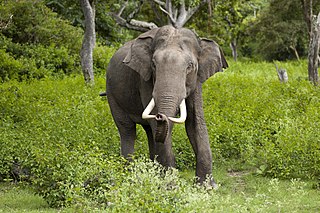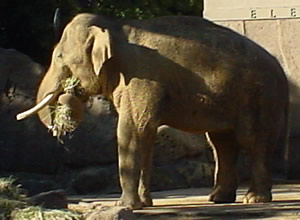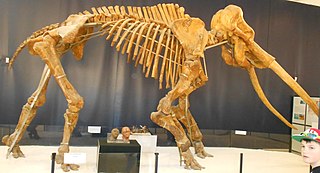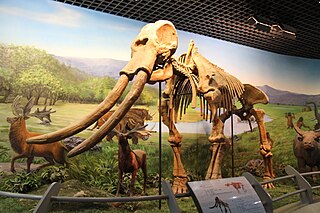
A mammoth is any species of the extinct elephantid genus Mammuthus. They lived from the late Miocene epoch into the Holocene about 4,000 years ago, and various species existed in Africa, Europe, Asia, and North America. Mammoths are distinguished from living elephants by their spirally twisted tusks and in at least some later species, the development of numerous adaptions to living in cold environments, including a thick layer of fur.

Proboscidea is a taxonomic order of afrotherian mammals containing one living family (Elephantidae) and several extinct families. First described by J. Illiger in 1811, it encompasses the elephants and their close relatives. Three species of elephant are currently recognised: the African bush elephant, the African forest elephant, and the Asian elephant.

Australopithecus (, OS-trə-lə-PITH-i-kəs, -loh-; or is a genus of early hominins that existed in Africa during the Pliocene and Early Pleistocene. The genera Homo, Paranthropus, and Kenyanthropus evolved from some Australopithecus species. Australopithecus is a member of the subtribe Australopithecina, which sometimes also includes Ardipithecus, though the term "australopithecine" is sometimes used to refer only to members of Australopithecus. Species include A. garhi, A. africanus, A. sediba, A. afarensis, A. anamensis, A. bahrelghazali and A. deyiremeda. Debate exists as to whether some Australopithecus species should be reclassified into new genera, or if Paranthropus and Kenyanthropus are synonymous with Australopithecus, in part because of the taxonomic inconsistency.

A mastodon is a member of the genus Mammut, which, strictly defined, was endemic to North America and lived from the late Miocene to the early Holocene. Mastodons belong to the order Proboscidea, the same order as elephants and mammoths. Mammut is the type genus of the extinct family Mammutidae, which diverged from the ancestors of modern elephants at least 27–25 million years ago, during the Oligocene.

Deinotherium is an extinct genus of large, elephant-like proboscideans that lived from about the middle-Miocene until the early Pleistocene. Although its appearance is reminiscent of modern elephants, Deinotherium possessed a notably more flexible neck, with limbs adapted to a more cursorial lifestyle, as well as tusks which grew down and curved back from the mandible, as opposed to the forward-growing maxillary tusks of extant elephants. Deinotherium was a widespread genus, ranging from East Africa, north to Southern Europe, and east to the Indian subcontinent. They were primarily browsing animals, with a diet largely consisting of leaves. The genus most likely went extinct due to environmental changes, such as forested areas gradually being replaced by open grasslands, during the latter half of the Neogene. Deinotherium thrived the longest in Africa, where they were found into the early Pleistocene.

Elephant shrews, also called jumping shrews or sengis, are small insectivorous mammals native to Africa, belonging to the family Macroscelididae, in the order Macroscelidea. Their traditional common English name "elephant shrew" comes from a perceived resemblance between their long noses and the trunk of an elephant, and their superficial similarity with shrews in the order Eulipotyphla. However, phylogenetic analysis has revealed that elephant shrews are not properly classified with true shrews, but are in fact more closely related to elephants than to shrews. In 1997, the biologist Jonathan Kingdon proposed that they instead be called "sengis", a term derived from the Bantu languages of Africa, and in 1998, they were classified into the new clade Afrotheria.

Elephantidae is a family of large, herbivorous proboscidean mammals collectively called elephants and mammoths. These are large terrestrial mammals with a snout modified into a trunk and teeth modified into tusks. Most genera and species in the family are extinct. Only two genera, Loxodonta and Elephas, are living.

A tenrec is a mammal belonging to any species within the afrotherian family Tenrecidae, which is endemic to Madagascar. Tenrecs are a very diverse group; as a result of convergent evolution, some resemble hedgehogs, shrews, opossums, rats, and mice. They occupy aquatic, arboreal, terrestrial, and fossorial environments. Some of these species, including the greater hedgehog tenrec, can be found in the Madagascar dry deciduous forests. However, the speciation rate in this group has been higher in humid forests.

Elephant birds are extinct flightless birds belonging to the order Aepyornithiformes that were native to the island of Madagascar. They are thought to have become extinct around 1000 AD, likely as a result of human activity. Elephant birds comprised three species, one in the genus Mullerornis, and two in Aepyornis.Aepyornis maximus is possibly the largest bird to have ever lived, with their eggs being the largest known for any amniote. Elephant birds are palaeognaths, and their closest living relatives are kiwi, suggesting that ratites did not diversify by vicariance during the breakup of Gondwana but instead convergently evolved flightlessness from ancestors that dispersed more recently by flying.

Mammutidae is an extinct family of proboscideans belonging to Elephantimorpha. It is best known for the mastodons, which inhabited North America from the Late Miocene until their extinction at beginning of the Holocene, around 11,000 years ago. The earliest fossils of the group are known from the Late Oligocene of Africa, around 24 million years ago, and fossils of the group have also been found across Eurasia. The name "mastodon" derives from Greek, μαστός "nipple" and ὀδούς "tooth", referring to their characteristic teeth.

Homo is a genus of great ape that emerged from the genus Australopithecus and encompasses only a single extant species, Homo sapiens, along with a number of extinct species classified as either ancestral or closely related to modern humans; these include Homo erectus and Homo neanderthalensis. The oldest member of the genus is Homo habilis, with records of just over 2 million years ago. Homo, together with the genus Paranthropus, is probably most closely related to the species Australopithecus africanus within Australopithecus. The closest living relatives of Homo are of the genus Pan, with the ancestors of Pan and Homo estimated to have diverged around 5.7-11 million years ago during the Late Miocene.

Elephas is one of two surviving genera in the family of elephants, Elephantidae, with one surviving species, the Asian elephant, Elephas maximus. Several extinct species have been identified as belonging to the genus, extending back to the Pliocene or possibly late Miocene.

Palaeoloxodon is an extinct genus of elephant. The genus originated in Africa during the Early Pleistocene, and expanded into Eurasia at the beginning of the Middle Pleistocene. The genus contains the largest known species of elephants, over 4 metres (13 ft) tall at the shoulders and over 13 tonnes (29,000 lb) in weight, representing among the largest land mammals ever, including the African Palaeoloxodon recki, the European straight-tusked elephant and the South Asian Palaeoloxodon namadicus. P. namadicus has been suggested to be the largest known land mammal by some authors based on extrapolation from fragmentary remains, though these estimates are highly speculative. In contrast, the genus also contains many species of dwarf elephants that evolved via insular dwarfism on islands in the Mediterranean, some like Palaeoloxodon falconeri less than 1 metre (3.3 ft) in shoulder height as fully grown adults, making them the smallest elephants known. The genus has a long and complex taxonomic history, and at various times, it has been considered to belong to Loxodonta or Elephas, but today is usually considered a valid and separate genus in its own right.

Ostriches are large flightless birds. Two living species are recognised, the common ostrich, native to large areas of sub-Saharan Africa, and the Somali ostrich, native to the Horn of Africa.

African elephants are members of the genus Loxodonta comprising two living elephant species, the African bush elephant and the smaller African forest elephant. Both are social herbivores with grey skin. However, they differ in the size and colour of their tusks as well as the shape and size of their ears and skulls.

The straight-tusked elephant is an extinct species of elephant that inhabited Europe and Western Asia during the Middle and Late Pleistocene. One of the largest known elephant species, mature fully grown bulls on average had a shoulder height of 4 metres (13 ft) and a weight of 13 tonnes (29,000 lb). Straight-tusked elephants likely lived very similarly to modern elephants, with herds of adult females and juveniles and solitary adult males. The species was primarily associated with temperate and Mediterranean woodland and forest habitats, flourishing during interglacial periods, when its range would extend across Europe as far north as Great Britain and eastwards into Russia. Skeletons found in association with stone tools and wooden spears suggest they were scavenged and hunted by early humans, including Neanderthals. It is the ancestor of most dwarf elephants that inhabited islands in the Mediterranean.

Rhynchocyon is a genus of elephant shrew in the family Macroscelididae. Members of this genus are known colloquially as giant sengis. They are a ground-dwelling mammal, significantly larger than their relatives in the order Macroscelidea that live primarily in dense forests across eastern Africa. Habitats range from eastern Africa's coastal forests, Rift Valley highlands, and the Congo basin. The species is widely threatened, with two of four assessed by the International Union for Conservation of Nature's Red List of Threatened Species. Habitat fragmentation from the growth of human settlements and activities are the primary threats to their populations. The genus contains the following five species and several subspecies:

The woolly mammoth is an extinct species of mammoth that lived from the Middle Pleistocene until its extinction in the Holocene epoch. It was one of the last in a line of mammoth species, beginning with the African Mammuthus subplanifrons in the early Pliocene. The woolly mammoth began to diverge from the steppe mammoth about 800,000 years ago in Siberia. Its closest extant relative is the Asian elephant. The Columbian mammoth lived alongside the woolly mammoth in North America, and DNA studies show that the two hybridised with each other.

The Hominidae, whose members are known as the great apes or hominids, are a taxonomic family of primates that includes eight extant species in four genera: Pongo ; Gorilla ; Pan ; and Homo, of which only modern humans remain.

Palaeoloxodon naumanni is an extinct species of elephant belonging to the genus Palaeoloxodon that was native to the Japanese archipelago during the Middle to Late Pleistocene around 330,000 to 24,000 years ago. It is named after the German geologist Heinrich Edmund Naumann who first described remains of the species in the 19th century, with the species sometimes being called Naumann's elephant. Fossils attributed to P. naumanni are also known from China, though the status of these specimens is unresolved, and some authors regard them as belonging to separate species.






















